Phenomenal Piqua Ladies
Many of Piqua's early social services and reform movements were started by women. Women established Piqua's first community organization, the Piqua Female Bible Society. Local reform movements, such as the Temperance movement, adult education, and community-wide welfare, all began because of women who demanded a better life for their neighbors and community.
The local suffragist movement counted its first significant success with Frances Meilly Orr's election to sit on the Board of Education. Joanna Hill Heitzman became the Chamber of Commerce's first woman president in 1983, and in 1991 Lucy Fess became the first female mayor and city commissioner.
Many of these notable women were also pioneers in their field, being the first women in male-dominated industries like medicine and journalism in our community.
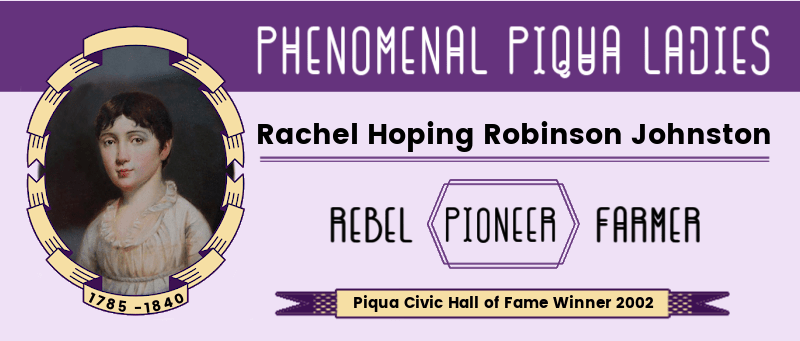
Rachel Hoping Robinson Johnston
Rachel Hoping Robinson was born, July 15, 1785, in Philadelphia, Pennsylvania. When she was 17, she eloped with Captain John Johnston, against her Quaker parent's wishes. Rachel and John traveled to Fort Wayne, where John was to work as an Indian Agent at the new trading agency. In 1811, the Johnstons moved to Upper Piqua. Rachel and John had fifteen children. Rachel oversaw the family farm and served as hostess to many Ohio leaders of the early nineteenth century. She established one of the earliest Sunday Schools in Miami County and organized the first civic organization in the Upper Miami Valley in 1818, the Piqua Female Bible Society.
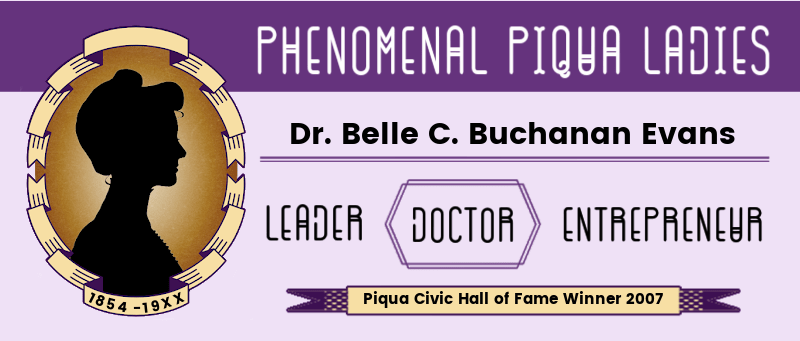
Dr. Belle C. Buchanan Evans
Belle C. Buchanan was born in Piqua in 1854, where she attended high school. She graduated from Pulte Medical College in 1883 as a homeopathic physician. Dr. Buchanan was Piqua's first female physician in the early 1880s, an era when medicine was dominated by men. She opened her practice in 1883 and focused on the care of women and children. Dr. Buchanan also ran a dispensary on the public square. She returned to Cincinnati to receive a second degree from the Women's Medical College in 1894. In 1897, she married Hial Evans.
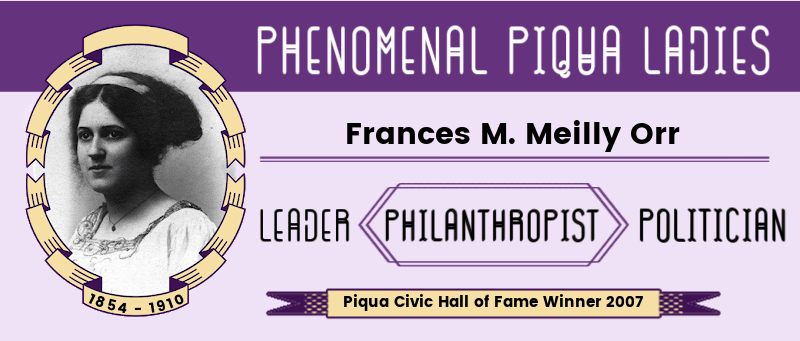
Frances M. Meilly Orr
Frances M. Meilly was born in 1854 in Lima, Ohio. She graduated from Western College in Oxford, Ohio. In 1884, she moved to Piqua with her husband, William P. Orr. She was the first woman ever elected to a public office in Piqua. She served on the Board of Education and promoted the first one-story cottage-style school in the Miami Valley, named Favorite Hill. She co-founded the Ladies Aid Society and served as the Ohio Federation of Women's Clubs president in 1899.
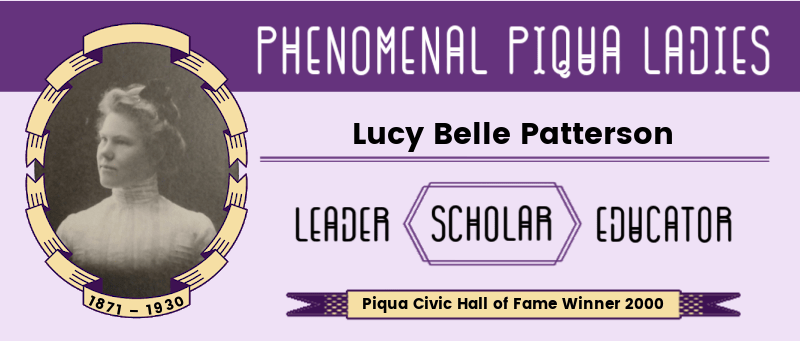
Lucy Belle Patterson
Lucy Belle Patterson Patterson was born near Piqua in 1871. She was one of the very few women in the 1890's to receive a bachelor's degree. Lucy continued her education, studying literature at the graduate level at Columbia University. For thirty-five years, she taught high school English. In 1919, Lucy was the founding president of the Piqua YWCA. She was also one of the founders of the local Story Teller's League.
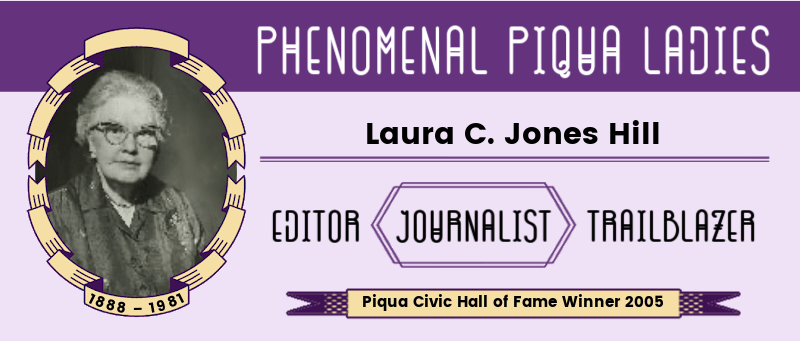
Laura C. Jones Hill
Laura C. Jones, "Lola," was born in Piqua in 1888. She was Judge Walter D. Jones's daughter. Lola began her newspaper career in 1914 with the Piqua Leader-Dispatch. She wrote all of her reports in longhand without a desk, using a tall stool against a counter instead. Lola was one of the community's earliest female reporters in the male world of journalism. She served as the society editor for the Piqua Daily Call from 1926 through 1964. She wrote a regular column, Piquaisms, which ran for over forty-six years.
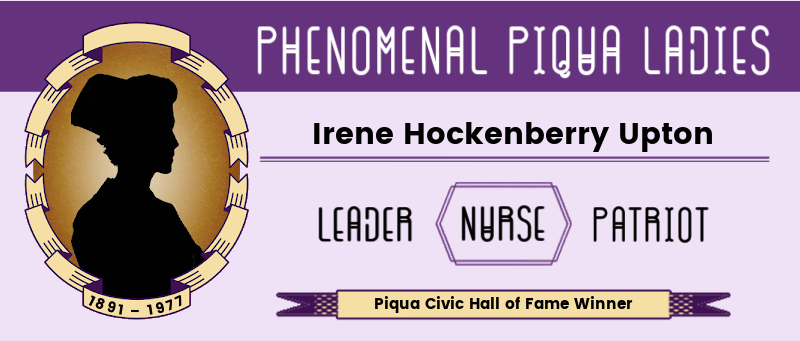
Irene Hockenberry Upton
Irene Hockenberry was born in Piqua in 1891. She graduated from Piqua High School in 1911. In 1914, she graduated from the Piqua Hospital Nursing School as a registered nurse. She moved to New York and worked in Brooklyn and New Jersey. In 1917, Irene joined the United States Army. She was stationed at Walter Reed Hospital until 1920. When she came home to Piqua, Irene became the city's public health nurse from 1921 through 1930. She was the first female member of the local American Legion. In 1938 she married Charles B. Upton.
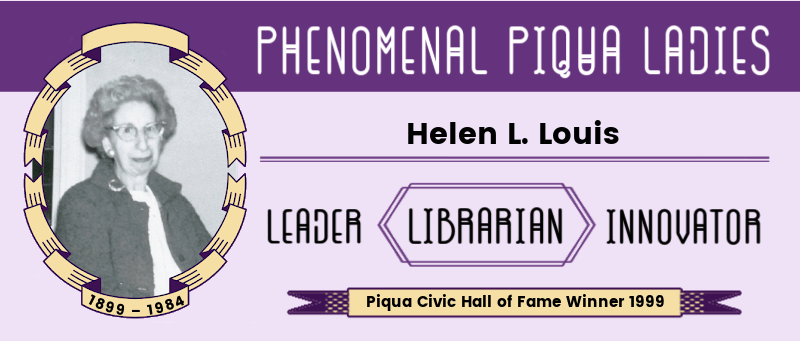
Helen L. Louis
Helen Louis was born in Piqua in 1899. She began working at Piqua's first library, the Schmidlapp Free School Library, in 1921. Helen was the library director from 1946 until 1966. She initiated many innovative programs, including providing circulating audio-visual materials to the public (one of the first five libraries in the state to offer this service), providing books to the hospital, and homebound. Helen was instrumental in creating new methods for adult learning in our community. The programming room, the Louis Room, at the Piqua Public Library is named in her memory.
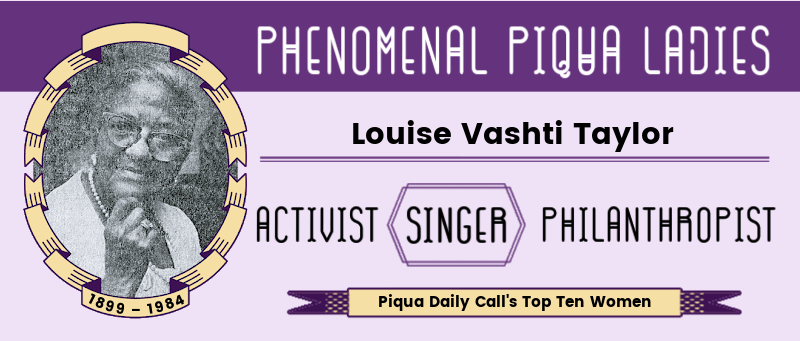
Louise Vashti Taylor
Louise Vashti Taylor was born in Paris, Kentucky, in 1900. She married her husband, Darrell Taylor when she was 17, and he was 21. Together they had fifteen children and various pets, from an alligator to cats, dogs, squirrels, and a crow named Oscar. In 1935, Louise, Darrell, and their children formed the Taylor Tots. The gospel-singing group sang throughout Ohio, including Piqua's WPTW radio station, from 1935 to 1949. Louise was a senior member of the Cyrene AME church and supervised the junior choir. She also promoted a local singing group, the Whispering Echoes (aka Hwisperian Echoes), which became a regional singing sensation.
Louise's involvement in her community went far beyond singing. She and Darrell helped organize the Piqua chapter of the NAACP in 1942. She helped to organize the city's first Black Girl Scout Troop in 1946. Louise owned her own dressmaker shop, was a Sunday school teacher for 40 years, and a missionary society member for 35 years. For fifteen years, she was a Ladies Aid Society member, serving as secretary for ten years. In 1972, Louise was included in the Piqua Daily Call's Top Ten Women.
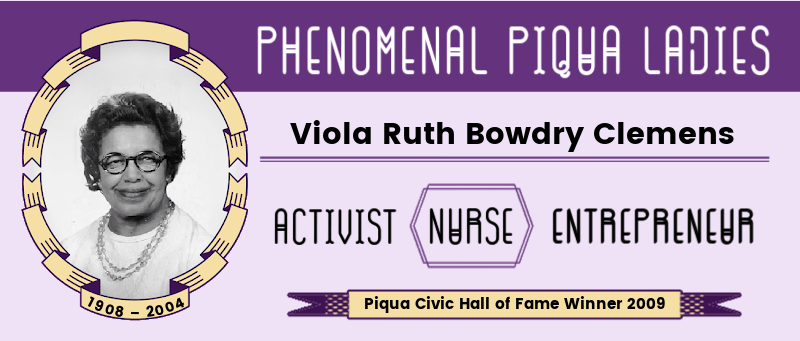
Viola Ruth Bowdry Clemens
Viola Ruth Bowdry was born in London, Ohio, in 1908. She and her husband, Emerson, moved to Piqua in 1925. She was trained as a nurse through the Red Cross during World War II and volunteered hundreds of hours at the Piqua Memorial Hospital. She was a charter member of the local chapter of the NAACP. Her activism in the 1940s helped end segregation in restaurants and movie theaters in Piqua. Viola was very active in her community, serving as a charter member of the Hospice of Miami County, Inc. Board of Directors, a co-founder of the Piqua Prayer Breakfast, and a Board member planning the Goodrich-Giles Public Park. She was the first Black member of Piqua Altrusa, a local women's professional group. Viola served on the YWCA board of directors, was a leader with the Negro Girl Reserves, and the Miami County Republican Women's Club treasurer. She was also a member of the Piqua Lions Club Auxiliary and the Forever 39 Club and an active member of the Cyrene A. M. E. Church.
Viola and Emerson owned a catering business, Clemens Caterers, from 1951 until 1983. In 1985, Viola and Emerson were designated king and queen of the Piqua Heritage Festival. Viola volunteered at the Piqua Memorial Medical Center for over twenty years. For her service, she was awarded the prestigious Order of George for outstanding community involvement.
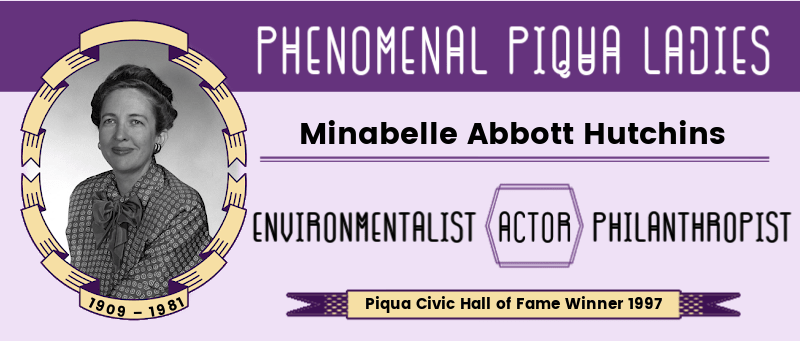
Minabelle Abbott Hutchins
Minabelle Abbott was born in 1909 in Dearborn County, Indiana. In the early 1930s, she got her start in radio in Cincinnati. Minabelle played the lead character in the radio soap opera Life of Mary Sothern from 1934 to 1938. The show followed wife and mother, Mary Sothern, for over 300 episodes. In 1946, Minabelle moved to Piqua and became one of Miami Valley's first radio stars on "Your Best Bet" from 1951 until 1976 on WPTW Radio. Through the Girl Scouts, Salvation Army, the American Red Cross, the American Cancer, and the Fine Arts Foundation, she was active in our community. She was also an avid bird watcher and lover of the natural world.
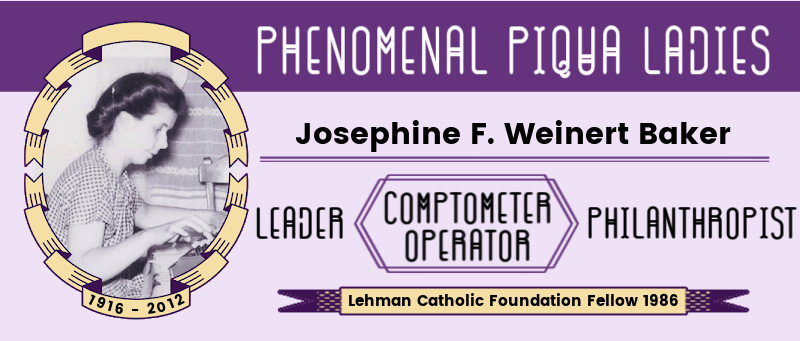
Josephine F. Weinert Baker
Josephine F. Weinert, "Jo" was born in 1916 in Dayton. She graduated from Julienne High School and the Dayton Comptometer School. Jo worked at the Kroger Grocery and Baking Company and later as the treasurer of WPTW Radio, Inc. and Valley Antenna Systems in Piqua.
She was very active in the community, serving on local boards and volunteering for many organizations, like the Piqua YWCA. She volunteered in the school cafeterias at Piqua Catholic, St. Mary Catholic, and Our Lady of Mercy Elementary School for over fifty years. Jo served as a charter member of the Good Samaritan Hospital Auxiliary, the Piqua Memorial Medical Center Auxiliary, and the Upper Valley Medical Center Auxiliary. She volunteered over 10,000 hours with these organizations. Jo also volunteered with the Green Valley Girl Scout Council and Buckeye Trails Girl Scout Council. In 1982, she was awarded the Buckeye Trails Girl Scout Service award. She was awarded the Lehman Catholic High School Foundation's Fellow Award in 1986.
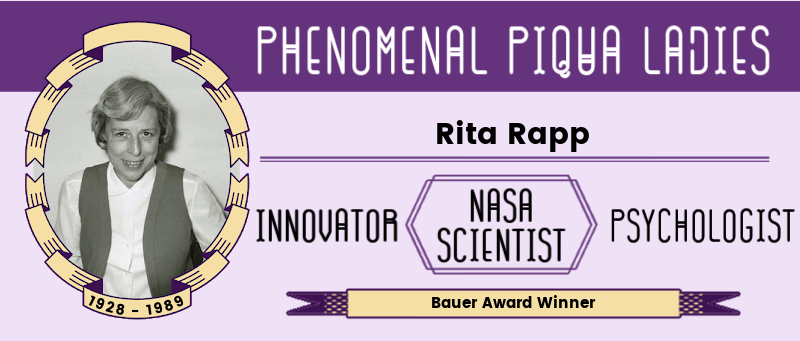
Rita Rapp
Rita Rapp was born in Piqua, Ohio, in 1928. She was a graduate of the University of Dayton and St. Louis University Graduate School. In 1956, Rita began working for the US Air Force Resource Laboratory at Wright Patterson Air Force Base. She worked as a research psychologist. Her medical expertise made her an excellent member of the NASA Space Task Group at Langley Field in 1961. She was transferred to the NASA Manned Space Craft Center in Houston, Texas, in 1962. She participated in many space launches starting with the first Mercury missions through the Space Shuttle program.
Rita is most well known for her development of food packaging systems for NASA astronauts. She served as the head of the Apollo Food System team. Her innovative designs were used in the Mercury, Gemini, Apollo, and Skylab programs. She worked closely with the astronauts on each mission to create recipes that they loved. Her sugar cookie cubes were one of the astronaut's favorites. The importance of her role was crucial to NASA missions. The psychological conditions of space travel, and the usually unappetizing, dehydrated food, caused many astronauts to lose appetites and weight. One of Rita's designs was called the "Spoon Bowl." This package allowed astronauts to use a spoon and eat similarly to how they would eat at home on Earth.
Rita wrote and co-wrote over twenty research papers and reports. She was awarded the Bauer Award for her work in space medicine, the University of Dayton Distinguished Alumni Award, United States Civil Service Commission of the Federal Women's Award, and two NASA Exceptional Service Medals. She was beloved by many NASA astronauts.
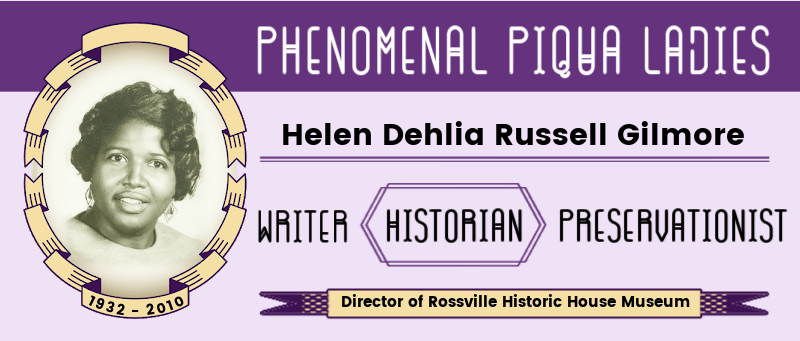
Helen Dehlia Russell Gilmore
Helen Dehlia Russell was born on September 21, 1932, in Piqua. She graduated from the Upper Valley Joint Vocational School and later worked in the Custodial Department. Helen and Issac B. Gilmore were married in 1953. Helen was the great-granddaughter of Isaac Rial, one of the Randolph Freedpeople. She studied her ancestry and wrote "The History of the Randolph Freed Slaves of Roanoke, Virginia who settled in Miami & Shelby Counties." Helen and Issac lived in her ancestors' home, the York Rial House. They spent eight years restoring it before turning it into the Rossville Historic House Museum. Helen founded the Springcreek Historical Society and was the director of the museum.
She preserved the history of the Randolph Freedpeople and Rossville. Helen got the York Rial House and the African Jackson Cemetery on the National Register of Historic Places. Through the museum, she preserved family artifacts collected by other Randolph Freedpeople descendants. Helen and Isaac bequeathed the museum's contents to the National Afro-American Museum and Cultural Center (NAAMCC). The NAAMCC and the Ohio History Connection used Gilmore's collection to create the exhibit Freed Will: The Randolph Freedpeople From Slavery to Settlement.
